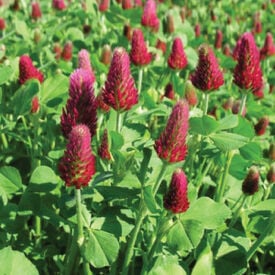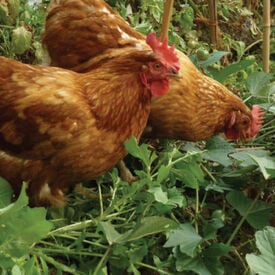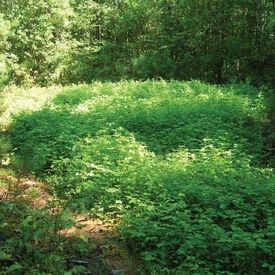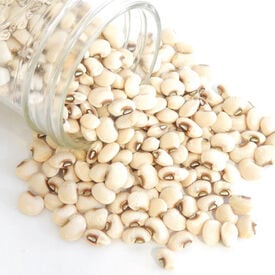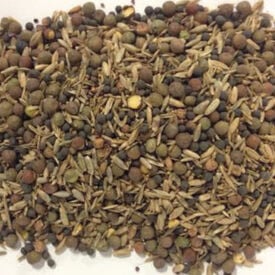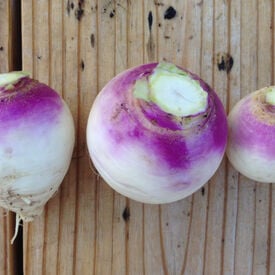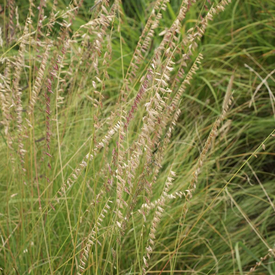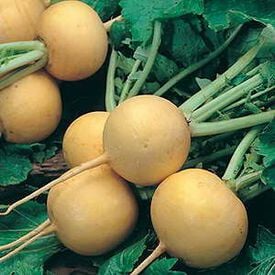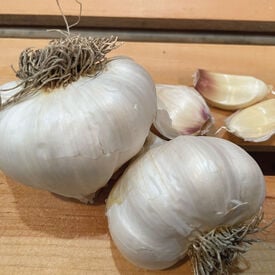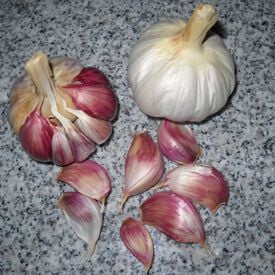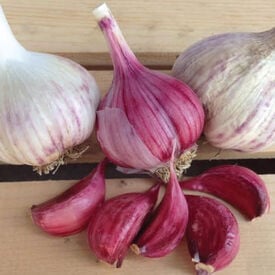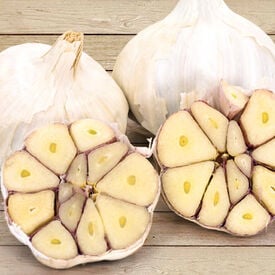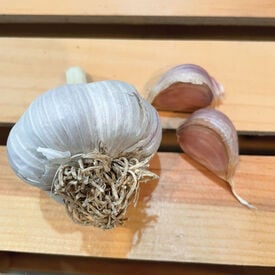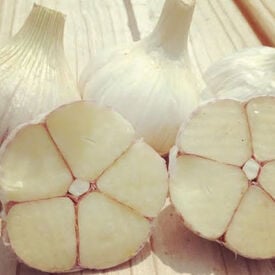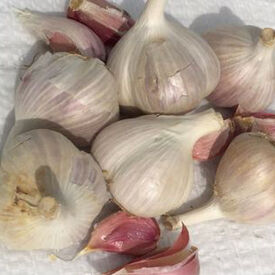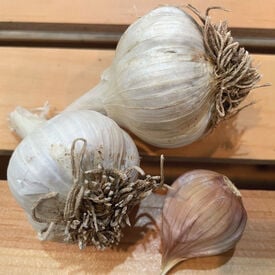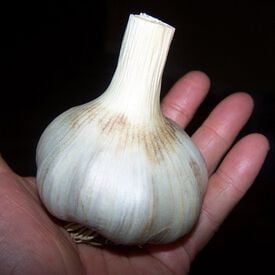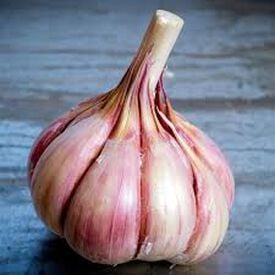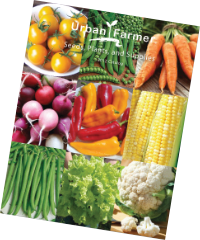The Crimson Clover is an attractive winter annual that can be planted fall or early spring and will protect and improve the soil. This good nitrogen fixer (70-150 lbs per acre per year) blooms showy crimson flowers in late spring that are an excellent source of nectar for bees. This variety inter-seeds well with grass, making it a great way to ready your vegetable garden for the spring or beautify a landscape! Not to be confused with the tough perennial clovers that can take over a meadow. Uses: Bees & Beneficial Insects, Chicken Forage, Compaction Control, Deer Attractant, Erosion Control, Forage, Green Manure, Nitrogen Fixation, No Till, Weed Suppression
Growing your own forage for your chickens is a cheap, easy, and a highly nutritious way to feed your chickens. Chicken feed can be expensive to provide throughout the year. Growing your own from spring to fall provides high levels of nutrients that will make your eggs taste even better. Foraging chickens have a better balanced diet that creates better eggs and meat. This chicken forage blend is a mix of well balanced plants that chickens love to eat. Spread at 5 lbs. per 1,000-2,000 square feet. 100 lbs will cover 1 acre. Mixture includes: Annual Ryegrass, Perennial Ryegrass, Buckwheat, Flax, Millet, Forage Peas, Red Clover, Alfalfa
All of the seeds below are very good at attracting deer to your property! Buckwheat - Improves top soil and an effective choke weed! Plant late spring to early summer. Establishes quickly. Matures in 60 days. Accumulates phosphorus and and potassium for following crops. Frost sensitive. All below packages come in 1lb. bags. Crimson Clover - Winter annual protects and improves soil! Plant fall or early spring. A good nitrogen fixer (70-150 lbs per acre per year). Showy crimson blooms in late spring are an excellent source of nectar for bees. Inter-seeds well with grass. Austrian Winter Pea - A great cool season legume for cover crops, wildlife and winter grazing! Austrian winter pea, sometimes called "black pea" and "field pea" is a cool-season, annual legume with good, nitrogen-fixing capabilities. Austrian winter pea is a low-growing, viny legume which has been shown to fix over 200 pounds of nitrogen per acre per year. Peas - Grow regular old peas in your deer food plot. One of the most preferred vegetables for deer. Oats - Oats will kill off winter weeds and hold soil with a mat of vegetation! A high yielding oat that can produce over 100 bushels per acre. Plant anytime of the year. Deer will graze oats all year round. Barkant Forage Turnip - Great forage crop that provides high energy feed! Barkant turnips are an improved, early maturing, diploid turnip wtih a large purple tankard shaped bulb. Barkant turnips have a high leaf to stem ratio and and provide very high contentrations of protein, sugar content and leaf yields. Barkant Turnips are ideally suited for wildlife. Dwarf Essex Rape - A cabbage related plant that is a perfect grazer! Dwarf Essex Rape is a perfect grazer plant that will persist well after the first frost. Ready to pasture 6-8 weeks after sowing. Hairy Vetch - Sow with or without grain, grass or field peas! When sown late summer, grows fast and will attract wildlife. Hairy Vetch has rapid growth that makes it a good weed suppressant.
The Big Boy Purplehull is a high yielding, popular Southern cowpea that is great for home gardens. Big Boy Purplehull is a long podded variety with 13-16 peas per pod that are light tan in color and oblong shape. This is a good garden variety and is very prolific. If you are using for Nitrogen fixation we highly recommend using a cowpea inoculant. Try with cowpea inoculant for maximum Nitrogen fixation.
A multipurpose cover crop blend that is sowed in fall! This wonderful blend will help with nitrogen fixation, adding organic matter and weed suppression. Contains a blend of Austrian Field Peas, Crimson Clover, Hairy Vetch, Annual and Winter Rye. Cut right after flowering in spring and till into soil for green manure. (30% Field Pea, 20% Crimson Clover, 20% Hairy Vetch, 15% Annual Rye, 15% Winter Rye) Seed Coverage: - 5 lbs covers 2,000-4,000 sqaure feet - 100 lbs covers 1-2 acres Uses: Green Manure, Nitrogen Fixation, No Till, Organic Matter (Biomass), Weed Suppression
The Purple Top White Globe Turnip is a beautifully purple and white colored turnip that is the best tasting turnip around! This turnip variety has a fine grained root that can grow as big as a baseball! The popular Purple Top White Globe is an excellent yielding turnip that is a great fall crop that gets even better with cold weather.
The Sideoats Grama is a warm-season bunchgrass grain variety that is easy to grow and native throughout much of North America. The ornamental and distinctive seed spikes hang from only one side of the stalk, and these make good fresh or dried cuttings. This grain prefers full sun and moderate to dry soils. The Sideoats Grama is recommended for meadow and prairie plantings, beds & borders, and as a component of forage mixes for livestock and wildlife.
The Golden Ball Turnip is a perfectly round, beautiful, eye catching golden turnip with a deliciously wonderful peppery taste! This turnip variety was introduced prior to 1859 and is still going strong! This is one turnip that you will want in your garden for its perfectly shaped 3-4" amber globes.
The Nootka Rose garlic is certified, and has a strong and aggressive flavor great for cooking. The Nootka Rose garlic was created on a farm in Washington State. The cloves have a dark coloration that are typically brown with red streaks. The Nootka Rose's bulbs tend to yield anywhere from 15-24 cloves each. This variety is a very long storing silverskin garlic. Approximately 12-15 garlic bulbs per pound. Approximately 15-24 cloves per bulb.
Ajo Rojo garlic has a delicious mild and creamy flavor. This variety comes from Spain and is very similar to the Creole Red but is a beautiful and distinctive garlic. The Ajo Rojo is mild and creamy when baked, but watch out if consuming raw - the heat comes on slowly and builds to intense!
Spanish Roja garlic is a certified, early season garlic harvest! This variety is a gourmet best-selling garlic for home gardens with an excellent classic rich flavor! Each bulb has about 8-12 cloves. Spanish Roja's outer wrapper varies in color, from a rich cream to deep purple stripes. Its cloves are large with a brownish red color and are easy to peel. This garlic keeps well, 4-6 months. During curing, many bulbs lose their stems. Approximately 8-12 cloves/ bulb. Approximately 65-85 garlic cloves/ pound.
Lorz Italian garlic, known for its exceptional flavor and culinary versatility, is a beloved garlic variety that hails from Italy. It is renowned for its unique characteristics that set it apart from other garlic varieties. Lorz Italian garlic typically produces medium to large-sized bulbs, often ranging from 2 to 2.5 inches (5 to 6.4 centimeters) in diameter. These bulbs are composed of multiple cloves, typically numbering between 8 to 12 cloves per bulb. One of the standout features of Lorz Italian garlic is its distinct flavor profile. It boasts a rich and robust garlic flavor with a subtle, sweet undertone, making it a favorite among chefs and home cooks alike. Its cloves are easy to peel and have a slightly spicy kick, which adds depth and complexity to a wide range of dishes. Lorz Italian garlic is versatile in the kitchen, lending its bold flavor to sauces, soups, roasted dishes, and more. Gardeners and garlic enthusiasts often appreciate Lorz Italian garlic for its adaptability to various growing conditions and climates. It can thrive in both cold and warm regions, making it a reliable choice for home gardeners looking to cultivate their garlic crop. With its generous number of cloves per bulb, Lorz Italian garlic is a popular choice for those who enjoy growing their garlic and harvesting bulbs with plenty of individual cloves for planting or culinary use.
Creme de la Rasa garlic is a hardneck variety that produces large, plump purple cloves! It is mild in heat, but rich in flavor. It is known to be hardy in the field, making it ideal for farmers! It is one of the several purple striped varieties we are offering this season!
German White garlic, scientifically known as Allium sativum 'German White,' is a popular garlic variety revered for its mild yet robust flavor and large bulb size. This garlic variety typically produces bulbs that are noticeably larger than other common garlic types, with a single bulb often reaching a diameter of 2 to 2.5 inches (5 to 6.35 cm). These bulbs are encased in a papery, white skin that protects the cloves within. Inside each German White garlic bulb, you'll find an impressive number of individual cloves. On average, a single bulb can contain anywhere from 6 to 8 cloves, although some bulbs may yield even more. These cloves are typically medium to large in size and are known for their easy-to-peel, plump, and juicy characteristics. German White garlic is favored by many chefs and home cooks alike for its versatile culinary applications, making it a staple in various dishes, from roasts to sauces, due to its well-balanced garlic flavor that isn't overpowering. In addition to its culinary appeal, German White garlic is also sought after for its adaptability in different climates and its ability to store well. Its robust growth and resistance to diseases make it a reliable choice for home gardeners and commercial growers. Overall, German White garlic is celebrated for its impressive bulb size and the generous number of cloves it offers, making it a cherished ingredient in the kitchen and an excellent addition to any garlic enthusiast's garden.
Majestic garlic is a hardneck porcelain variety that is discovered by Beaver Pond Estates. This variety is a porcelain garlic so it does best in colder climates and develops large bulbs with a mild flavor. This garlic will mature later in the season and has excellent storage life.
Leningrad garlic, also known as Russian Red garlic or Allium sativum 'Leningrad,' is a distinctive garlic variety renowned for its robust flavor and impressive adaptability. This heirloom garlic hails from the city of Leningrad, now known as Saint Petersburg, in Russia. It is characterized by its large, purple-striped bulbs and rich, complex flavor profile. Leningrad garlic is classified as a hardneck garlic, meaning it produces a woody central stalk called a scape, which can be harvested and used in culinary applications as well. One of the standout features of Leningrad garlic is its ability to thrive in colder climates. It is well-suited for regions with harsh winters, making it a favorite among northern gardeners. The cloves are typically planted in the fall and harvested in mid-summer the following year. Leningrad garlic is appreciated for its strong, spicy flavor with a hint of sweetness, which intensifies when roasted. Its cloves are easy to peel, making it a convenient choice for home cooks and chefs alike.
German Giant is just like its name says, a very large garlic with an excellent flavor! This garlic variety is a large garlic that has become popular for its strong, spicy flavor. Many believe German Giant to be one of the best tasting garlics available! This garlic is off-white often with deep purple streaks. Approximately 6 garlic bulbs per pound. Approximately 6-8 cloves per bulb.
The Persian Star is a hardneck purple stripe type garlic. The outer skin can grow pure white with inner wrappers that are streaked purple. The red-tipped cloves with marbled streaks on whitish or yellow-brown background. The Persian Star is a very pleasant flavor with a mild spicy zing that is a great addition to any dish!
